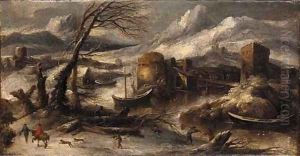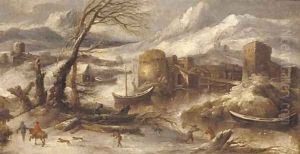Willem Von Bemmel Paintings
Willem van Bemmel, also known as Guiliam or Wilhelm von Bemmel, was a Dutch Golden Age landscape painter who was born in Utrecht in the Netherlands in 1630. He was known for his picturesque landscapes, often characterized by their Italianate style, reflective of the influence of the Roman Campagna, despite the fact that he spent much of his career in Germany and Austria.
As a young artist, van Bemmel trained under Herman Saftleven in Utrecht, where he honed his skills in landscape painting. In his early career, he traveled extensively, which was a common practice among Dutch artists of the time who sought to study landscapes and classical ruins. His travels led him to the German Rhineland and eventually to Nuremberg in 1651, where he joined the painter's academy and became a master painter. His work during this period often depicted the German countryside and was marked by a clear, bright palette and precise detailing.
In 1662, Willem van Bemmel moved to Vienna, where he gained the patronage of prominent figures, including the Holy Roman Emperor Leopold I. His reputation grew, and he was appointed court painter, a prestigious position that allowed him to influence the development of landscape painting in the region. His landscapes from this period often feature dramatic skies and a softer, more atmospheric quality, indicating a shift in his artistic approach influenced by his surroundings and perhaps the changing tastes of the time.
Van Bemmel's influence extended beyond his own practice as he became a teacher to other artists, thus playing a role in the dissemination of Dutch landscape styles into Central Europe. His works were collected by aristocrats and royalty, contributing to his fame during his lifetime.
Willem van Bemmel's death occurred in 1708 in Nuremberg, where he had returned later in his life. Despite the fact that he spent many years outside of the Netherlands, his art maintained a distinctly Dutch sensibility, and he is remembered as part of the wave of Dutch artists who spread the influence of their homeland's artistic traditions throughout Europe.

